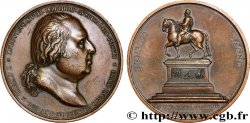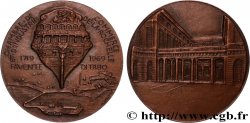Live auction - fme_895924 - LOUIS XVIII Médaille, Conseil d’État, Narcisse-Achille de Salvandy
You must signin and be an approved bidder to bid, LOGIN TO BID. Accounts are subject to approval and the approval process takes place within 48 hours. Do not wait until the day a sale closes to register. Clicking on "BID" constitutes acceptance of the terms of use of cgb.fr private live auctions.
Bids must be placed in whole Euro amounts only. The sale will start closing at the time stated on the item description; any bids received at the site after the closing time will not be executed. Transmission times may vary and bids could be rejected if you wait until the last second. For further information check the Live auction FAQ
All winning bids are subject to a 18% buyer’s fee.
All winning bids are subject to a 18% buyer’s fee.
| Estimate : | 200 € |
| Price : | 290 € |
| Maximum bid : | 601 € |
| End of the sale : | 09 July 2024 17:26:10 |
| bidders : | 2 bidders |
Type : Médaille, Conseil d’État, Narcisse-Achille de Salvandy
Date: n.d.
Metal : silver
Diameter : 40,5 mm
Orientation dies : 12 h.
Engraver ANDRIEU Jean-Bertrand (1761-1822) / DE PUYMAURIN Jean-Pierre (1757-1841)
Weight : 41,39 g.
Edge : lisse
Puncheon : sans poinçon
Coments on the condition:
Médaille nettoyée, présentant de nombreux coups et rayures, notamment sur la tranche. De l’usure sur les reliefs, en particulier à l’avers
Obverse
Obverse legend : LOUIS XVIII ROI DE - FRANCE ET DE NAVARRE..
Obverse description : Buste habillé de profil à droite, signé sur le tranché du bras : ANDRIEU F. et PUYMAURIN D..
Reverse
Reverse legend : CONSEIL D’ETAT / - / N. A. DE / SALVANDY.
Reverse description : Légende en 3 lignes dans une couronne de chêne, sommée d’une couronne. Signé : BARRE.
Commentary
La médaille a été décernée à Narcisse-Achille de Salvandy (1795-1856).
Né dans une famille de petite noblesse de robe d'origine irlandaise, il s'engagea en 1813 dans les gardes d'honneur de Napoléon Ier sous le nom de « Salvandy de la Gravière ». Brigadier le 26 mai 1813, sous-lieutenant le 16 juin, il prit une part active en 1813-1814, à la guerre de Saxe et à la campagne de France, durant laquelle il fut blessé, et fut promu adjudant-major.
Entré dans la maison militaire du roi, lors du retour des Bourbons, il suivit, peu après les cours de l'Ecole de droit. Il publia, pendant les Cent-jours, quelques brochures libérales. Dévoué dès lors au parti constitutionnel, il fit paraître, sous ce titre: la Coalition et la France (1816), un écrit des plus vifs contre l'occupation étrangère. Les alliés réclamèrent son arrestation ; mais le roi refusa, et, après l'évacuation du territoire, le duc de Richelieu le nomma maître des requêtes au conseil d'Etat. Il fut par la suite destitué de ses fonctions de conseiller d’Etat par monsieur de Peyronnet en 1821.
Parmi ses nombreuses autres fonctions, il fut membre de la chambre des députés avec 8 mandats (1830-1831 et 1833-1848), ministre de l’instruction publique (3 mandats : 1937-1939 et 1845-1848), ambassadeur de France en Espagne.
cf. wikipedia et assemblée nationale
https://www2.assemblee-nationale.fr/sycomore/fiche/(num_dept)/14412.
The medal was awarded to Narcisse-Achille de Salvandy (1795-1856).
Born into a family of minor nobility of Irish origin, he joined Napoleon I's guards of honour in 1813 under the name of \\\"Salvandy de la Gravière\\\". Brigadier on May 26, 1813, second lieutenant on June 16, he took an active part in 1813-1814, in the Saxon war and in the French campaign, during which he was wounded, and was promoted to adjutant-major.
Having entered the king's military household upon the return of the Bourbons, he shortly after attended the Law School.. During the Hundred Days, he published some liberal brochures.. Devoted from then on to the constitutional party, he published, under the title: The Coalition and France (1816), a most lively writing against foreign occupation.. The allies demanded his arrest; but the king refused, and, after the evacuation of the territory, the Duke of Richelieu appointed him master of requests to the Council of State.. He was subsequently dismissed from his duties as State Councilor by Monsieur de Peyronnet in 1821..
Among his many other positions, he was a member of the Chamber of Deputies with 8 terms (1830-1831 and 1833-1848), Minister of Public Education (3 terms: 1937-1939 and 1845-1848), French Ambassador to Spain.
cf. Wikipedia and National Assembly https://www2. National Assembly. fr/sycamore/fiche/(num_dept)/14412
Né dans une famille de petite noblesse de robe d'origine irlandaise, il s'engagea en 1813 dans les gardes d'honneur de Napoléon Ier sous le nom de « Salvandy de la Gravière ». Brigadier le 26 mai 1813, sous-lieutenant le 16 juin, il prit une part active en 1813-1814, à la guerre de Saxe et à la campagne de France, durant laquelle il fut blessé, et fut promu adjudant-major.
Entré dans la maison militaire du roi, lors du retour des Bourbons, il suivit, peu après les cours de l'Ecole de droit. Il publia, pendant les Cent-jours, quelques brochures libérales. Dévoué dès lors au parti constitutionnel, il fit paraître, sous ce titre: la Coalition et la France (1816), un écrit des plus vifs contre l'occupation étrangère. Les alliés réclamèrent son arrestation ; mais le roi refusa, et, après l'évacuation du territoire, le duc de Richelieu le nomma maître des requêtes au conseil d'Etat. Il fut par la suite destitué de ses fonctions de conseiller d’Etat par monsieur de Peyronnet en 1821.
Parmi ses nombreuses autres fonctions, il fut membre de la chambre des députés avec 8 mandats (1830-1831 et 1833-1848), ministre de l’instruction publique (3 mandats : 1937-1939 et 1845-1848), ambassadeur de France en Espagne.
cf. wikipedia et assemblée nationale
https://www2.assemblee-nationale.fr/sycomore/fiche/(num_dept)/14412.
The medal was awarded to Narcisse-Achille de Salvandy (1795-1856).
Born into a family of minor nobility of Irish origin, he joined Napoleon I's guards of honour in 1813 under the name of \\\"Salvandy de la Gravière\\\". Brigadier on May 26, 1813, second lieutenant on June 16, he took an active part in 1813-1814, in the Saxon war and in the French campaign, during which he was wounded, and was promoted to adjutant-major.
Having entered the king's military household upon the return of the Bourbons, he shortly after attended the Law School.. During the Hundred Days, he published some liberal brochures.. Devoted from then on to the constitutional party, he published, under the title: The Coalition and France (1816), a most lively writing against foreign occupation.. The allies demanded his arrest; but the king refused, and, after the evacuation of the territory, the Duke of Richelieu appointed him master of requests to the Council of State.. He was subsequently dismissed from his duties as State Councilor by Monsieur de Peyronnet in 1821..
Among his many other positions, he was a member of the Chamber of Deputies with 8 terms (1830-1831 and 1833-1848), Minister of Public Education (3 terms: 1937-1939 and 1845-1848), French Ambassador to Spain.
cf. Wikipedia and National Assembly https://www2. National Assembly. fr/sycamore/fiche/(num_dept)/14412








 Report a mistake
Report a mistake Print the page
Print the page Share my selection
Share my selection Ask a question
Ask a question Consign / sell
Consign / sell
 Full data
Full data















